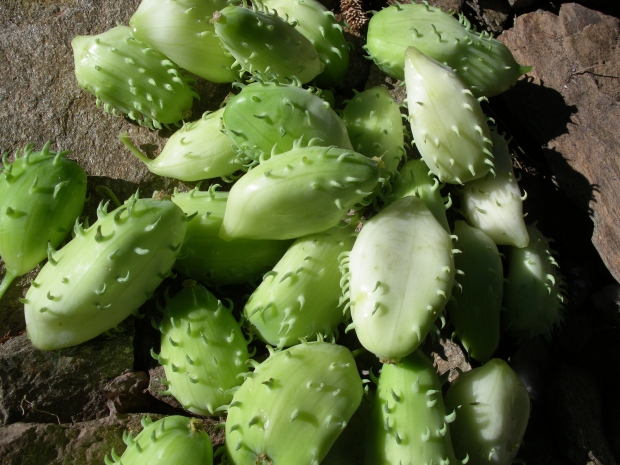Cucurbitaceae (Cyclanthera pedata or brachystachya)
Tender annual
Sometimes referred to as a stuffing cucumber, Caigua, In the Andes (quencha) it is also widely called “caihua”. Elsewhere, it is known as pepino de rellenar (Colombia), pepino andino (Venezuela), and variations on “achoca” and “caihua.”[2]
A climbing cucurbit from Peru with thin vines producing an abundant harvest of edible, hollow, green, pods or ‘gourds’ 6-15cm long with a spongy interior containing a dozen or more hard black seeds. There are two achocha species; ‘Fat Baby’ (Cyclanthera brachystachya) producing single fruits which are fat and covered in soft, fleshy spines and ‘Lady’s slipper’ (Cyclanthera pedata) which sets smooth fruits in pairs that are more elongated and slightly curved like a Persian slipper.[1]
Origin Native to Central and South America – from Mexico south to Ecuador, Peru and Bolivia now considered one of the ‘lost crops of the Incas’. ‘Caigua’ is currently cultivated as a food in the Carribean, Central and South America.
Site & Soil ‘The plant prefers light (sandy), medium (loamy) and heavy (clay) soils and requires well-drained soil. The plant prefers acid, neutral and basic (alkaline) soils..It can grow in semi-shade (light woodland).It requires moist soil’[3].
Propagation Grow in the same way as other tender cucurbits. Sow in pots 4 weeks before planting out after the last spring frost.
Care Provide protection until plants are established and provide a climbing frame, pergola, trellis or wigwam for the plants to scramble over.
Spread plants can grow 4.5metres and are best grown vertically though they can be left to scramble over the ground between larger plants.
Harvest Pick regularly to increase production. Immature fruits (before the seeds have formed) taste and look like tiny cucumbers. Pick when small and eat as green vegetables raw or cooked. As the pods grow they become hollow when they are best cooked with the seeds removed.
Storage The fruits keep well for a week or more in a cool place.
Botany and Seed Saving Achocha do not cross with other cucurbits and saving seed is straight forward simply pick or scrape the seeds out of the mature pods, dry and store. ‘The flowers are monoecious (individual flowers are either male or female, but both sexes can be found on the same plant) and are pollinated by Insects.’[4]
Use The immature fruits may be eaten raw or pickled. Unlike many cucurbitaceous fruits, the fruit are more like pods and become quite hollow as they mature, and the mature fruit is often eaten stuffed. In South America the fruits are used like peppers – either raw or cooked (after the seeds are removed). They are also stuffed with meat, fish or cheese and then baked.” In Ecuador a soup is made with the fruit. Like many cucurbits the leaves and tender young shoots are delicious cooked and used as greens.
Medicinal A tea can be made of the seeds is used for controlling high blood pressure. Caigua is traditionally taken to reduce blood cholesterol levels. It has various traditional medicinal usages, mainly to control cholesterol, reduce obesity, control high blood pressure, regulate the metabolism of lipids and sugar in the blood stream and decrease cholesterol.
[1] Emma Cooper – http://www.coopette.com/articles/growing-achocha
[2]Lost Crops of the Incas: Little-Known Plants of the Andes with Promise for Worldwide Cultivation (1989) Squashes and Their Relatives (202-209)
[3] Plants for a Future http://www.pfaf.org/user/Plant.aspx?LatinName=Cyclanthera+pedata
[4] Plants for a Future http://www.pfaf.org/user/Plant.aspx?LatinName=Cyclanthera+pedata


